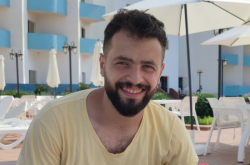The “ITMO University Peak” project was conceived three years ago; it was then that you, as part of an expedition, went on a sort of a “reconnaissance trip” before the final ascension.
In February of 2015, at mountaineering training session at the university’s climbing wall, I’d had a wild thought: why isn’t there a peak named after ITMO University? Why don’t we find one? I shared my thoughts with Alexei Orudzhev, who is a coach at our mountaineering club and a long-time friend of my son and mine, who supported the proposal. We began planning, which resulted in a three-year project to find and climb a peak that has nobody had set foot before.
In choosing the region and the peak, our main criteria were the height, difficulty of route and accessibility of the general area. In the more accessible regions, there are very few significant peaks left unexplored, and so we had to come to terms with the fact that the journey wouldn’t be simple. In addition, the peak would need to be sufficiently visible and picturesque, with an altitude of 4,000 to 5,000 meters. And thus, we ended up with the choice of the Pamir-Alay, a mountain system in the south-east part of Central Asia, situated in Tajikistan, Kyrgyzstan and Uzbekistan.
Back in 2015, our team had first gone to Pamir-Alay and found a mountain that fit all of our criteria; however, we were only able to go up to the “shoulder” of the mountain, at the height of 4,506 meters. Due to several issues, we had to take a break and delay the ascension. Still, it can’t be said that the first attempt was a failure – we had found the right peak, beautiful and sufficiently tall and difficult, scouted the route and acquainted ourselves with the locals. We were going to go back last year – we’d even bought tickets already, but my companion, Alexei, had injured a ligament, and so we had to delay our second trip until the summer of 2017.
Did the line-up of your team change much this year?
This time around, four of us went to Pamir: me, Alexei Orudzhev, Igor Kononykhin – an engineer at ITMO’s “Russar” center, an athlete and an expert in optical instrumentation, and Natalia Avstrikova, a member of our sports club.

Planning the expedition
Three out of the four of us were present during the 2015 expedition, which was made up of a group of mountaineers and tourists. The latter changed their plans, while the three of us continued on. However, three is not a perfect combination – four is much better for splitting into two pairs. We’d planned that our pair (Alexei and Me) would set out first, with Igor and Natalia arriving a week later and following our path.
We arrived there on July 14 and expected them to come a week after us. But it wasn’t without trouble; their plane was preparing for takeoff when a malfunction was discovered and the flight was delayed, making our second pair three days late. By that time, we had finished our reconnaissance and, as the weather cleared out, could not wait for them any longer. We’d decided to go without them, while they arrived a day later and observed us from camp.
Were there any other complications during your trip?
There was another interesting part. In order to get to the truly unexplored peaks next to the Lenin Peak, one needs to go through a place called the “Onion Clearing”, from the opposite shore of the Achik-Tash River. It is a great mountain river that originates from the 12 kilometer-long Lenin Glacier, one of the largest glaciers in the area. The river has steep, scree-covered shores and a powerful current. In most places you can’t even approach the water, not to mention cross it. On our last trip two years ago, we had crossed it with great difficulty. There was no bridge and we had to set up our own crossing using ropes; a local family cut it down later. It was an unpleasant situation: as we later discovered, the thieves used our ITMO-branded (they didn’t even bother removing the logo) rope to hitch their horses. We found them and persuaded them to compensate for our troubles and help us cross the river. The story has its closure: this family was later run out by the locals and moved to a different area; on the site of our crossing, the locals constructed a bridge.

A Google Earth view of the ITMO Peak (marked) from the south
This year we also approached the Lenin Peak from a different direction than the one most mountaineers use. We went to the opposite shore, where one can only get on horseback with help from locals. We’d had a local acquaintance just like that. We tried to contact him in advance, back in May to June, but our calls couldn’t come through. At some point, I decided to send a telegram, not even knowing his full name. I only remembered that his name was Amid and which village he lived in, so that’s what I wrote in the telegram: Kyrgyzstan, Osh Region, Sary-Mogol village, to Amid. Even the name, it turned out, was incorrect – I was supposed to spell it as “Aamid”.
I was told that there is no post office or a telegraph at that address, so it would be sent to Osh, printed and taken to Sary-Mogol by car, from where it would be taken on horseback to the summer pastures where he is most likely to be found. A few days later, in the middle of some academic meeting, I get a call from Aamid. He’d received the telegram and called me; we talked everything over and later on we met up without complications. This was a good sign for our trip.
How did the trek go and how many days did it take you to get to the summit?
We left St. Petersburg with Alexei and arrived to Osh on July 15. After getting food at the market, we drove to Sary-Mogol, where Aamid met us with horses.

The team's guide, Aamid, on a pasture
We spent the first few days scouting. We didn’t aim to pick the most difficult route – you never do that during the first ascent; first, you discover the mountain and only then you try a more challenging route. On the other hand, we did not want the route to be too simple.
Our goal was a peak not far (about 10 kilometers) from the Lenin Peak. At first, I planned to approach it from the south, as we were already quite familiar with the northern area – I myself had been on the Lenin Peak itself exactly 50 years ago, in 1967. The southern side was supposed to be less snowy and icy, which is why we wanted to explore in that direction. But, having inspected it, we realized that the southern route would not be very exciting, though it would be very suitable for descent in event of an emergency.
What we did like was the northern approach, but not on the north-east ridge – the one we climbed in 2015 – but the western ridge of the northern wall. Having scouted the western ridge, we returned to the base camp.

Prof. Veiko and Aamid's sons outside a yurt in the basecamp, with the Lenin Peak in the background
Overall, scouting took us about 5 days: a day for the first approach from south, two days for another one, then two more days for the northern approach.
Then we took a day of rest, which coincided with the “goat-dragging” holiday in the Alay Valley (in the goat-dragging game, two teams of riders compete over a goat carcass, which they then need to throw into a circle in the middle of a large field – seen as a competition for “true men”).
People come together, have contests, cook plov, shashlik, meats and vegetables, all sorts of activities.

Goat-dragging
Was the weather accommodating on your journey?
I think we got really lucky with the weather. In terms of mountaineering weather, it was good. Although when we were just about ready to begin the final ascent, a heavy rain started, and we had to delay our hike. We checked the forecast and it showed that on July 24 to 26 there would be a “window” of clear weather. In the end, everything went well and we didn’t have any complications during the ascent – probably because we’d spent so much time preparing and knew the mountain thoroughly. The route we chose was the correct one. After all the preparations and checking the forecast, we went out for three days – on the first, we reached the summit camp, began the ascent on day two – it took us nine and a half hours to get to the summit – and came back down on the third day.
You still have to prepare a report and register your ascent. How do you even confirm something like that? Mountaineers usually have special rituals that they perform at mountain summits.
It should be noted that the ITMO University Peak turned out to be not just a mountain, but an entire ridge – a mountain system of sorts. It has an Eastern summit and a Western one, from which massive ridges originate. There is a symbolism to it, as ITMO University, too, looks both East and West.
We definitely have rituals. First off, we build a cairn, inside of which we place a capsule with a note. It says “Mountaineering group from St. Petersburg, ITMO University, having conducted a preliminary scouting of the approach, ascent and descent routes – from the north along the north-east ridge of the North wall (2015), from the north along the western ridge of the North wall (2017) and from the south along the valleys of the rivers Aryn-Dzhilga and Kokchkhur (2017) – has completed the first ascent of the unnamed peak, at altitude of 4729 meters above sea level on the Achik-Tash ridge from the valley of Konok-Dzhilga River along the western ridge of the North wall. Ascended the Western peak on July 25 2017 at 1PM, having left at 7AM from a camp under the col of the western ridge. In our right as the first explorers, we give this summit the name of the “ITMO University Peak”. Best of luck to future explorers!”

Vadim Veiko and the ITMO University Peak
The goal you’ve been chasing for three years has now been reached. Have you got any new plans in mind?
I do. It’s related to both sports and science. The thing is, there is a lot in common between the effects of lasers on matter and volcanoes: similar temperatures and pressures, but different scale. It’s no coincidence that the impact site left by a laser on metal or other matter is referred to as a crater. Once, when I was on the summit of the Teide volcano on Tenerife, I saw a sight that seemed to me extremely familiar. Later I realized that I’d seen something similar in the lens of a microscope.
When a laser beam is applied to a material, the crater it leaves is similar in appearance to a caldera. It made me think about the similarities. I think one could find something interesting exploring this theme. I’d like to work on that in the future. There is a colleague of mine, – and a friend – who is a member of the Russian Academy of Science and has a master of sports in mountaineering; he is, too, interested in this topic.

Alexei Orudzhev displays ITMO University's flag at the Western summit
Do you think observing natural occurrences can help discover something new for lasers science?
Perhaps. Or perhaps it would be the opposite. Such an analogy can be quite helpful if we develop the theory of laser action and apply it to volcanic activity. In any case, I think that studying these things will be useful for both. A project like this could be submitted to the Russian Foundation for Fundamental Research, even.
Are there any places of interests you’re already considering – volcanoes of Kamchatka, for example, or are you open to anything for now?
It’s too early to say. Generally, there are no reasons to limit ourselves with just Russia or Kamchatka – there are some interesting volcanoes in Mexico, New Guinea. We’ll see how it goes.






